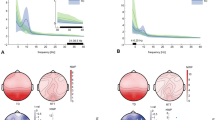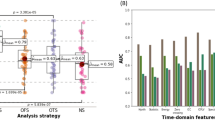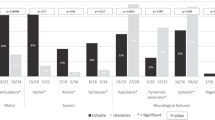Abstract
Rolandic epilepsy (RE) is the most common human epilepsy, affecting children between 3 and 12 years of age, boys more often than girls (3:2). Focal sharp waves in the centrotemporal area define the electroencephalographic (EEG) trait for the syndrome, are a feature of several related childhood epilepsies and are frequently observed in common developmental disorders (eg, speech dyspraxia, attention deficit hyperactivity disorder and developmental coordination disorder). Here we report the first genome-wide linkage scan in RE for the EEG trait, centrotemporal sharp waves (CTS), with genome-wide linkage of CTS to 11p13 (HLOD 4.30). Pure likelihood statistical analysis refined our linkage peak by fine mapping CTS to variants in Elongator Protein Complex 4 (ELP4) in two independent data sets; the strongest evidence was with rs986527 in intron 9 of ELP4, providing a likelihood ratio of 629:1 (P=0.0002) in favor of an association. Resequencing of ELP4 coding, flanking and promoter regions revealed no significant exonic polymorphisms. This is the first report of a gene implicated in a common focal epilepsy and the first human disease association of ELP4. ELP4 is a component of the Elongator complex, involved in transcription and tRNA modification. Elongator depletion results in the brain-specific downregulation of genes implicated in cell motility and migration. We hypothesize that a non-coding mutation in ELP4 impairs brain-specific Elongator-mediated interaction of genes implicated in brain development, resulting in susceptibility to seizures and neurodevelopmental disorders.
Similar content being viewed by others
Log in or create a free account to read this content
Gain free access to this article, as well as selected content from this journal and more on nature.com
or
References
Shinnar S, O’Dell C, Berg AT : Distribution of epilepsy syndromes in a cohort of children prospectively monitored from the time of their first unprovoked seizure. Epilepsia 1999; 40: 1378–1383.
Beaussart M : Benign epilepsy of children with Rolandic (centro-temporal) paroxysmal foci: a clinical entity. Study of 221 cases. Epilepsia 1972; 13: 795–811.
Clarke T, Strug LJ, Murphy PL et al: High risk of reading disability and speech sound disorder in rolandic epilepsy families: case–control study. Epilepsia 2007; 48: 2258–2265.
Kavros PM, Clarke T, Strug LJ, Halperin JM, Dorta NJ, Pal DK : Attention impairment in rolandic epilepsy: systematic review. Epilepsia 2008; 49: 1570–1580.
Boxerman J, Hawash K, Bali B, Clarke T, Rogg J, Pal DK : Is Rolandic epilepsy associated with abnormalities on cranial MRI? Epilepsy Res 2007; 75: 180–185.
Eeg-Olofsson O, Petersen I, Sellden U : The development of the electroencephalogram in normal children from the age of 1 through 15 years. Paroxysmal activity. Neuropadiatrie 1971; 2: 375–404.
Echenne B, Cheminal R, Rivier F, Negre C, Touchon J, Billiard M : Epileptic electroencephalographic abnormalities and developmental dysphasias: a study of 32 patients. Brain Dev 1992; 14: 216–225.
Holtmann M, Becker K, Kentner-Figura B, Schmidt MH : Increased frequency of rolandic spikes in ADHD children. Epilepsia 2003; 44: 1241–1244.
Scabar A, Devescovi R, Blason L, Bravar L, Carrozzi M : Comorbidity of DCD and SLI: significance of epileptiform activity during sleep. Child Care Health Dev 2006; 32: 733–739.
Doose H, Neubauer B, Carlsson G : Children with benign focal sharp waves in the EEG – developmental disorders and epilepsy. Neuropediatrics 1996; 27: 227–241.
Heijbel J, Blom S, Rasmuson M : Benign epilepsy of childhood with centrotemporal EEG foci: a genetic study. Epilepsia 1975; 16: 285–293.
Scheffer IE, Jones L, Pozzebon M, Howell RA, Saling MM, Berkovic SF : Autosomal dominant rolandic epilepsy and speech dyspraxia: a new syndrome with anticipation. Ann Neurol 1995; 38: 633–642.
Guerrini R, Bonanni P, Nardocci N et al: Autosomal recessive Rolandic epilepsy with paroxysmal exercise-induced dystonia and writer's cramp: delineation of the syndrome and gene mapping to chromosome 16p12–11.2. Ann Neurol 1999; 45: 344–352.
Roll P, Rudolf G, Pereira S et al: SRPX2 mutations in disorders of language cortex and cognition. Hum Mol Genet 2006; 15: 1195–1207.
Kugler SL, Bali B, Lieberman P et al: An autosomal dominant genetically heterogeneous variant of rolandic epilepsy. Epilepsia 2008; 49: 1086–1090.
Bali B, Kull L, Strug L et al: Autosomal dominant inheritance of centrotemporal sharp waves in rolandic epilepsy families. Epilepsia 2007; 48: 2266–2272.
Neubauer BA, Fiedler B, Himmelein B et al: Centrotemporal spikes in families with rolandic epilepsy: linkage to chromosome 15q14. Neurology 1998; 51: 1608–1612.
Royall RM : Statistical Evidence: A Likelihood Paradigm. London: Chapman and Hall, 1997.
Blume JD : Tutorial in biostatistics: likelihood methods for measuring statistical evidence. Stat Med 2002; 21: 2563–2599.
Strug LJ, Hodge SE : An alternative foundation for the planning and evaluation of linkage analysis. I. Decoupling ‘error probabilities’ from ‘measures of evidence’. Hum Hered 2006; 61: 166–188.
Strug LJ, Rohde CA, Corey PN : An introduction to evidential sample size calculations. Am Stat 2007; 61: 207–212.
Commission on classification and terminology of the international league against epilepsy: proposal for revised classification of epilepsies and epileptic syndromes. Epilepsia 1989; 30: 389–399.
Hodge SE, Abreu P, Greenberg DA : Magnitude of type I error when single-locus linkage analysis is maximized over models: a simulation study. Am J Hum Genet 1997; 60: 217–227.
Abreu PC, Hodge SE, Greenberg DA : Quantification of type i error probabilities for heterogeneity LOD scores. Genet Epidemiol 2002; 22: 159–169.
Pal DK, Durner M, Greenberg DA : Effect of misspecification of gene frequency on the two-point lod score. Am J Hum Genet 2001; 9: 855–859.
Kruglyak L, Daly MJ, Reeve-Daly MP, Lander ES : Parametric and nonparametric linkage analysis: a unified multipoint approach. Am J Hum Genet 1996; 58: 1347–1363.
Daw EW, Thompson EA, Wijsman EM : Bias in multipoint linkage analysis arising from map misspecification. Genet Epidemiol 2000; 19: 366–380.
Barrett JC, Fry B, Maller J, Daly MJ : Haploview: analysis and visualization of LD and haplotype maps. Bioinformatics 2005; 21: 263–265.
Strug LJ, Hodge SE : An alternative foundation for the planning and evaluation of linkage analysis. II. Implications for multiple test adjustments. Hum Hered 2006; 61: 200–209.
Benjamini Y, Hochberg Y : Controlling the false discovery rate: a practical and powerful approach to multiple testing. J R Stat Soc B 1995; 57: 289–300.
Laird NM, Horvath S, Xu X : Implementing a unified approach to family-based tests of association. Genet Epidemiol 2000; 19 (Suppl 1): S36–S42.
Lindsey JK : Parametric Statistical Inference. Oxford: Clarendon Press, 1996.
Kong A, Gudbjartsson DF, Sainz J et al: A high-resolution recombination map of the human genome. Nat Genet 2002; 31: 241–247.
Vieland VJ, Hodge SE : Review of statistical evidence: a likelihood paradigm by Royall, R. Am J Hum Genet 1998; 63: 283–289.
Clayton D, Chapman J, Cooper J : Use of unphased multilocus genotype data in indirect association studies. Genet Epidemiol 2004; 27: 415–428.
Otero G, Fellows J, Li Y et al: Elongator, a multisubunit component of a novel RNA polymerase II holoenzyme for transcriptional elongation. Mol Cell 1999; 3: 109–118.
Svejstrup JQ : Elongator complex: how many roles does it play? Curr Opin Cell Biol 2007; 19: 331–336.
Krogan NJ, Greenblatt JF : Characterization of a six-subunit holo–elongator complex required for the regulated expression of a group of genes in Saccharomyces cerevisiae. Mol Cell Biol 2001; 21: 8203–8212.
Esberg A, Huang B, Johansson MJ, Bystrom AS : Elevated levels of two tRNA species bypass the requirement for elongator complex in transcription and exocytosis. Mol Cell 2006; 24: 139–148.
Close P, Hawkes N, Cornez I et al: Transcription impairment and cell migration defects in elongator-depleted cells: implication for familial dysautonomia. Mol Cell 2006; 22: 521–531.
Niedermeyer E, McKusick VA, Brunt P, Mahloudji M : The EEG in familial dysautonomia (Riley–Day syndrome). Electroencephalogr Clin Neurophysiol 1967; 22: 473–475.
Anderson SL, Coli R, Daly IW et al: Familial dysautonomia is caused by mutations of the IKAP gene. Am J Hum Genet 2001; 68: 753–758.
Slaugenhaupt SA, Blumenfeld A, Gill SP et al: Tissue-specific expression of a splicing mutation in the IKBKAP gene causes familial dysautonomia. Am J Hum Genet 2001; 68: 598–605.
Mezey E, Parmalee A, Szalayova I et al: Of splice and men: what does the distribution of IKAP mRNA in the rat tell us about the pathogenesis of familial dysautonomia? Brain Res 2003; 983: 209–214.
Griffin C, Kleinjan DA, Doe B, van Heyningen V : New 3′ elements control Pax6 expression in the developing pretectum, neural retina and olfactory region. Mech Dev 2002; 112: 89–100.
Royall RM : On the probability of observing misleading statistical evidence (with discussion). J Am Stat Assoc 2000; 95: 760–780.
Acknowledgements
We thank the families participating in the IRELAND study (http://www.rolandic.com); Irina Gurvich PhD, Regina Santella PhD, Fengli Zhang MD, Frances Rhoads MD, Jerry Boxerman MD PhD, Jeffrey Rogg MD, Lewis Kull MS, Geoffrey Tremont PhD, Janessa Carvalho BS, Suzanne Foster BS, George Cholankeril, Doe West PhD, Kieran Hartsough BS, Lynne Capuano, Somaria Persaud; and the members of the IRELAND consortium: Cigdem Akman MD, William D Brown MD, Murray Engel MD, John Gaitanis MD, Frank Gilliam MD, Karameh Hawash MD, Huntley Hardison MD, Geoffrey Heyer MD, Steven L Kugler MD, Linda Leary MD, David E Mandelbaum MD PhD, Patricia McGoldrick RN, Edward Novotny MD, Steven M Wolf MD and Maria Younes MD. This study was supported by members of the Partnership for Pediatric Epilepsy Research, which includes the American Epilepsy Society, the Epilepsy Foundation, Anna and Jim Fantaci, Fight Against Childhood Epilepsy and Seizures (faces), Neurotherapy Ventures Charitable Research Fund and Parents Against Childhood Epilepsy (PACE) (DKP); the Epilepsy Foundation through the generous support of the Charles L Shor Foundation for Epilepsy Research Inc. (DKP); People Against Childhood Epilepsy (PACE) (DKP), National Institutes of Health grants NS047530 (DKP) and HG00-4314 (LJS). The content is solely the responsibility of the authors and does not necessarily represent the official views of the National Institute Of Neurological Disorders And Stroke, the National Institutes of Health or any other sponsor. We acknowledge Professor Hermann Doose's intellectual contribution to the nosology of focal sharp wave-associated phenotypes in children. We thank Dr Susan E Hodge for critical reading of the paper; Dr Andreas Kottman and Dr Livio Pellizzoni for helpful discussions.
Author information
Authors and Affiliations
Corresponding author
Additional information
Web resources
Mendelian variants of RE are listed in Online Inheritance in Man http://www.ncbi.nlm.nih.gov/sites/entrez?db=omim. The Haploview application can be downloaded at http://www.broad.mit.edu/mpg/haploview. Information about marker location can be found at UniSTS at the NCBI website above and through the Ensembl genome browser at http://www.ensembl.org/Homo_sapiens/Info/Index. SNP frequencies were accessed at dbSNP: http://www.ncbi.nlm.nih.gov/projects/SNP.The ESE Finder program was used to assess alternative exon 10 of ELP4 and can be accessed at http://rulai.cshl.edu/cgi-bin/tools/ESE3/esefinder.cgi?process=home. For bioinformatic analyses of ELP4 protein variants produced by alternative gene splicing we used PHI-BLAST, and accessed the following PANTHER and Bioinformatics websites: http://www.pantherdb.org and http://bioinformatics.weizmann.ac.il/blocks/blockmkr/www/make_blocks.html.
Supplementary Information accompanies the paper on European Journal of Human Genetics website (http://www.nature.com/ejhg)
Supplementary information
Rights and permissions
About this article
Cite this article
Strug, L., Clarke, T., Chiang, T. et al. Centrotemporal sharp wave EEG trait in rolandic epilepsy maps to Elongator Protein Complex 4 (ELP4). Eur J Hum Genet 17, 1171–1181 (2009). https://doi.org/10.1038/ejhg.2008.267
Received:
Revised:
Accepted:
Published:
Issue date:
DOI: https://doi.org/10.1038/ejhg.2008.267
Keywords
This article is cited by
-
Genetik und genetische Diagnostik fokaler Epilepsien des Kindesalters – Was? Wann? Warum?
Clinical Epileptology (2024)
-
Gut microbiome dysbiosis drives metabolic dysfunction in Familial dysautonomia
Nature Communications (2023)
-
A novel ELP1 mutation impairs the function of the Elongator complex and causes a severe neurodevelopmental phenotype
Journal of Human Genetics (2023)
-
Influence of epileptogenic region on brain structural changes in Rolandic epilepsy
Brain Imaging and Behavior (2022)
-
Clinical and molecular findings in a Turkish family with an ultra-rare condition, ELP2-related neurodevelopmental disorder
Molecular Biology Reports (2021)



